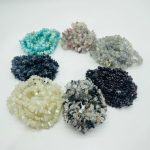Introduction: Seeking the Untamed Beauty
Raw tourmaline, a captivating gemstone in its pristine form, embodies a mesmerizing allure that has captivated collectors and artisans alike. Unlike its polished counterparts, raw tourmaline remains unadorned, preserving the rugged beauty of its natural crystalline structure. Its intricate facets and vibrant colors paint a story of geological wonders, inviting us to delve into the captivating world of this enigmatic mineral.

Geological Genesis: A Journey Through Time
Tourmaline’s origins lie deep within the Earth’s crust. Formed under intense heat and pressure, it is a complex silicate mineral that crystallizes in a hexagonal prism shape. The presence of various trace elements during its formation grants tourmaline its breathtaking array of colors, ranging from vivid greens and pinks to ethereal blues and yellows.
The Mystique of Raw Tourmaline: Unlocking Ancient Traditions
For centuries, raw tourmaline has held a profound significance in numerous cultures worldwide. Native American tribes revered it as a spiritual guardian, while ancient healers believed in its medicinal properties. Its captivating hues were thought to promote emotional balance, enhance intuition, and protect against negative energies. Today, raw tourmaline continues to be a cherished amulet, adorning jewelry and talismans as a symbol of protection and well-being.
Properties and Applications: A Tapestry of Uses
Physical Properties:
- Mohs Scale Hardness: 7-7.5
- Crystal System: Hexagonal
- Color: Varies widely, including black, blue, green, pink, red, and yellow
- Transparency: Opaque to transparent
Applications:
- Jewelry Making: Raw tourmaline’s intricate facets and vibrant colors lend themselves beautifully to jewelry design, creating unique and eye-catching pieces.
- Healing and Metaphysical Practices: In alternative healing modalities, raw tourmaline is believed to possess therapeutic and spiritual properties, promoting emotional balance, reducing stress, and enhancing intuition.
- Industrial Applications: Black tourmaline, also known as schorl, is used as a flux in the production of ceramics and glass.
- Emerging Applications: Scientists are exploring the use of tourmaline in advanced materials, such as solar cells, piezoelectric sensors, and medical imaging.
Value and Market Trends: A Geological Commodity
Raw tourmaline’s value is determined by its size, color, clarity, and rarity. Large, well-formed crystals with intense colors and minimal inclusions command premium prices. The global market for raw tourmaline is estimated to be worth over $1 billion annually, with Brazil, Afghanistan, and Nigeria being the leading producers.
Table 1: Key Sources of Raw Tourmaline
| Country | Production (2023) |
|---|---|
| Brazil | 60,000 tons |
| Afghanistan | 15,000 tons |
| Nigeria | 10,000 tons |
| United States | 5,000 tons |
| Mozambique | 3,000 tons |
Table 2: Color Variations and Associated Meanings
| Color | Meaning |
|---|---|
| Black (Schorl) | Protection, grounding |
| Blue (Indicolite) | Communication, clarity |
| Green (Verdelite) | Healing, growth |
| Pink (Rubellite) | Love, compassion |
| Red (Rubellite) | Passion, vitality |
| Yellow (Canary) | Joy, optimism |
Table 3: Applications of Raw Tourmaline
| Application | Description |
|---|---|
| Jewelry | Unique and eye-catching pieces |
| Healing and Metaphysics | Promotes emotional balance, reduces stress |
| Industrial | Flux in ceramics and glass production |
| Advanced Materials | Potential use in solar cells, sensors, and medical imaging |
Table 4: Factors Influencing Raw Tourmaline’s Value
| Factor | Impact on Value |
|---|---|
| Size | Larger crystals are more valuable |
| Color | Intense and rare colors command higher prices |
| Clarity | Minimal inclusions increase value |
| Rarity | Unique and rare specimens fetch higher prices |
Common Mistakes to Avoid: Preserving the Natural Beauty
- Excessive Polishing: Avoid over-polishing raw tourmaline, as it can remove its unique surface texture and diminish its value.
- Heat Treatment: Avoid heat treatment as it can alter the natural color and transparency of raw tourmaline.
- Cleaning with Harsh Chemicals: Use mild detergents and avoid using harsh chemicals that can damage the surface of raw tourmaline.
- Storing in Direct Sunlight: Prolonged exposure to direct sunlight can fade the color of raw tourmaline.
FAQs: Demystifying Raw Tourmaline
1. Is raw tourmaline more valuable than polished tourmaline?
In general, yes. Raw tourmaline’s natural beauty and unique characteristics often make it more valuable than polished tourmaline.
2. What is the most expensive color of raw tourmaline?
Red rubellite is generally the most expensive color of raw tourmaline.
3. How can I tell if my raw tourmaline is real?
Genuine raw tourmaline typically has an uneven surface texture, irregular shape, and visible inclusions.
4. How do I care for raw tourmaline?
Store raw tourmaline in a cool, dry place and clean it regularly with mild detergents. Avoid heat and direct sunlight.
5. Can I wear raw tourmaline jewelry every day?
Yes, you can wear raw tourmaline jewelry every day as long as you care for it properly.
6. What is raw tourmaline good for?
In alternative healing practices, raw tourmaline is believed to promote emotional balance, reduce stress, and enhance intuition.
7. What is schorl?
Schorl is the black variety of tourmaline and is used in industrial applications as a flux in ceramics and glass production.
8. Where can I find raw tourmaline for sale?
Raw tourmaline can be found at mineral shows, online retailers, and specialized jewelry stores.
Conclusion: Embracing the Raw, Untamed Essence
Raw tourmaline is a captivating gemstone that embodies the pristine beauty and raw power of nature. Its intricate facets, vibrant colors, and rich history make it a coveted material for jewelry making, healing practices, and emerging applications. By understanding its properties, applications, and value, we can appreciate the multifaceted allure of this remarkable gemstone in its untamed state. As we embrace the raw beauty of tourmaline, let us remember its enduring legacy as a symbol of protection, well-being, and the unyielding spirit of the Earth.




























